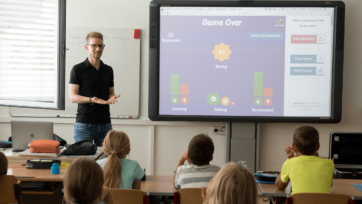The Magic of Vocabulary
By Bianka Walsh

Riding the influencer wave: How to get your resources into the hands of Aussie teachers.
Words … like an artist’s brush, they paint the world with vivid shades of meaning. Vocabulary holds an immense power, capable of unlocking the realms of imagination, and acting as a superpower in education programs. Yes, dear readers, today we embark on an exploration of words, delving deep into their significance in shaping the cognitive development of children.
Do your education programs include a focus on robust vocabulary? Are you currently working on a new campaign or school program? Education resources that incorporate vocabulary will have a big impact on students’ communication, comprehension and creativity. Kimberlin Education are experts in guiding the development of programs with a strong focus on effective vocabulary.
Vocabulary plays a fundamental role in the reading process and is critical to reading comprehension. Children learn the meanings of most words indirectly, through everyday experiences with oral and written language. Other words are learned through explicit teacher instruction and it is important that education programs identify and teach subject-specific vocabulary.
Vocabulary can be sorted into three tiers: tier 1, tier 2,and tier 3.
Tier 1 words consist of basic, familiar words such as house, sun, walk, play. These words are commonly used in everyday conversation. Most students come to school with a good repertoire of Tier 1 vocabulary words.
Tier 2 words are robust, high-frequency words that students encounter across subject areas such as investigate, discuss, report, compare. They are not used as widely in speech and daily conversation. Understanding and using tier 2 words increases the precision of students’ comprehension and writing.
Tier 3 vocabulary words are low-frequency, content-specific words such as evaporation, denominator and contrast. They are usually only used when they relate to a specific topic as they have distinct meanings and purposes. Sometimes, an everyday word has a different meaning in the context of a particular subject and falls into the category of tier 3 vocabulary, such as cloud (technology), cube (mathematics). When education programs focus on tier 3 vocabulary through the inclusion of explicit vocabulary instruction, it can have a big impact on students’ engagement with your content.
Have you considered how students will engage with your school program content and what would appeal to teachers? When students encounter tier 3 vocabulary within the context of their lessons, they gain a deeper understanding of subject matter and develop critical thinking skills. Through explicit instruction, engaging activities, and meaningful discussions, educators can facilitate the acquisition and application of tier 3 vocabulary. By encouraging students to use specific vocabulary in their spoken and written language, teachers and students can confidently explore and explain their understanding of the topic.
From expanding reading comprehension to fostering social interactions and even boosting academic success, the power of words extends far beyond the confines of language alone. Kimberlin Education has a wealth of experience in unlocking the hidden treasures that lie within the pages of dictionaries and aligning them with your school programs.
Next steps?
Kimberlin Education can develop education programs which are made for teachers, by teachers. Contact us today to discuss how our team of experts can help you!




